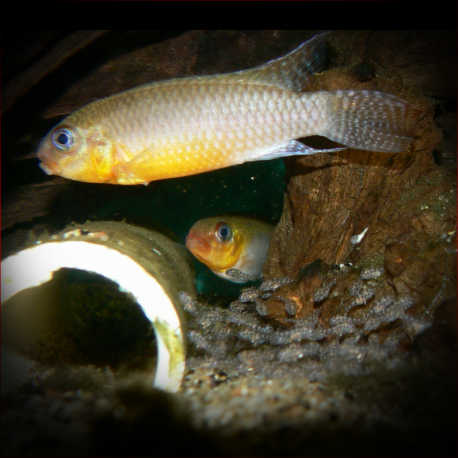More info
Datasheet
| Minimum Tank Size | 60 litres / 15.85 US gallons |
| Maximum Size | 7.0cm / 2.76inches |
| Temperature | 24°C / 75.20°F - 27°C / 80.60°F |
| Hardness | 0.00dgH / 0ppm - 3.03dgH / 54ppm |
| pH | 4.0-6.0 |
General Description
Congochromis sabinae, a member of the family Cichlidae, is a benthic detritivore known for its striking appearance. Described as a regional form of the species in the 1960s, it was initially labeled with various names before its official classification. With a maximum size of 7.0 cm, this species showcases unique body features such as a rounded head profile, rounded snout, and a distinctive black lateral body stripe that does not extend into the caudal fin. Additionally, male Congochromis sabinae exhibit white and red submarginal bands in the upper caudal fin lobe.
Aquarium Setup
When setting up an aquarium for Congochromis sabinae, it is crucial to replicate its natural habitat to promote its well-being. The ideal tank should include soft, sandy substrate and provide caves or potential spawning sites using driftwood, clay flowerpots, or coconut shells. Adding dried leaf litter and dim lighting can further enhance the natural feel of the environment. It is recommended to include aquatic plants like Anubias or Cryptocoryne spp. for cover and microbe development. Water conditions should maintain a pH range of 4.0-6.0, hardness of 0-54 ppm, and a temperature range of 24-27°C (see table).
Behaviour
Congochromis sabinae can be kept in a community tank if tankmates are carefully selected, preferably small, non-aggressive species. They are non-gregarious and territorial, making it advisable to keep a single pair in most tanks to avoid conflicts. During breeding, they exhibit monogamous, bi-parental cave spawning behavior. Pairing is relatively simple, with the female initiating courtship and the male overseeing territorial defense.
Feeding and Diet
In the wild, Congochromis sabinae feed primarily on plant material and organic detritus. In captivity, they should be fed a variety of high-quality, fine-grade prepared foods rich in Spirulina. Occasional offerings of live or frozen foods like bloodworms, Daphnia, or mosquito larvae are recommended. Homemade gelatine-bound recipes with a mix of dried fish food, shellfish, fruits, and vegetables are also beneficial for their diet.
Reproduction & Dimorphism
During reproduction, Congochromis sabinae engage in bi-parental care, with the female responsible for brood care inside the cave while the male guards the surrounding area. Males exhibit distinct coloration changes during courtship, displaying intense red to orange pigmentation. In terms of sexual dimorphism, adult males display unique colors and patterns on their fins and body compared to females, with males showcasing white and red submarginal bands in the upper caudal fin lobe.
Habitat and Distribution
Congochromis sabinae are predominantly found in rainforest streams and tributaries in northeastern Congo, specifically in the Loubi River within the Congo river system. They have also been recorded in parts of Gabon and the Democratic Republic of Congo. This species prefers shallow, densely vegetated waters with reddish-brown, tannin-stained water conditions. Fish collected for the trade are often mislabeled with inaccurate collection localities, so caution is advised when considering this information.

